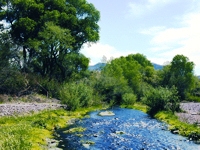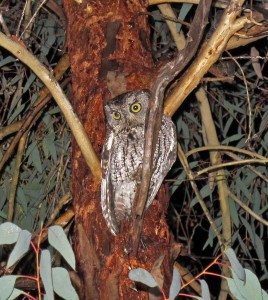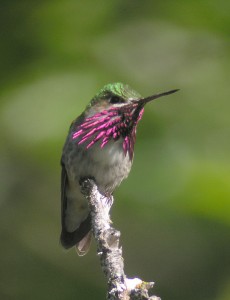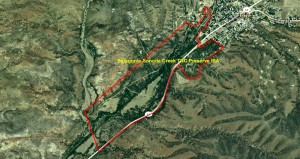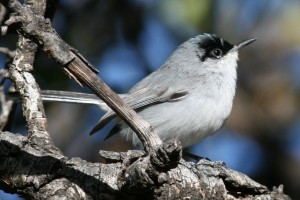Site Stewards: The Nature Conservancy and Tucson Audubon
Size: 0.6 square miles, 387 acres
Identified: 07/2010
Visiting the IBA: Patagonia-Sonoita Creek Preserve is 60 miles southeast of Tucson. Take I-10 east to Highway 83 exit south to Sonoita then turn west onto Highway 82. In Patagonia, turn west on 4th Avenue. Turn south on Pennsylvania, cross the creek, and go about one mile to the entrance. You can also visit the Paton Center for Hummingbirds within this IBA managed by the Tucson Audubon Society which is an excellent place to sit comfortably and watch the busy bird feeders. This is a very reliable spot for Violet-crowned Hummingbirds.
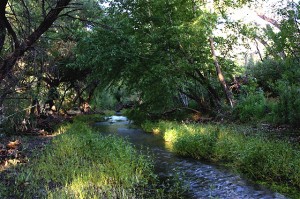 Ownership and Management: The Nature Conservancy and the Tucson Audubon Society for the Paton Center for Hummingbirds.
Ownership and Management: The Nature Conservancy and the Tucson Audubon Society for the Paton Center for Hummingbirds.
Site Description: This IBA has some of the richest of the remaining riparian (streamside) habitat in the region in a verdant floodplain valley between the Patagonia and Santa Rita Mountains of southeastern Arizona. As one of a few remaining permanent streams, it provides habitat for a wide array of diverse species from endangered fishes to butterflies and birds. The preserve protects a magnificent example of the rare Fremont cottonwood-Goodding willow riparian forest. Some of the trees are among the largest (more than 100 feet tall) and oldest (130 years old) Fremont cottonwood trees in the US. This is one of the few remaining sites in Arizona where this once-common forest type still persists.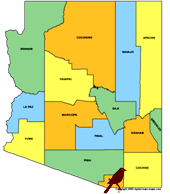
Birds: The primary factors for the large diversity of bird species (including rarities) here are the riparian forest, reliable surface water, and proximity to the Huachuca Mountains IBA, one of the Sky Islands in the Sierra Madre Occidental.
Year-round: Abert’s Towhee, Great Blue Heron, Western Screech-Owl, Anna’s Hummingbird, Broadbilled Hummingbird, Violet-crowned Hummingbird, Gilded Flicker, Black Phoebe. Bridled Titmouse, Crissal Thrasher, and Rufous-crowned Sparrow.
Breeding: Gray Hawk, Zone-tailed Hawk, Inca Dove Yellow Warbler, Lucy’s Warbler, Bell’s Vireo, Northern Beardless-Tyrannulet, Yellow-billed Cuckoo, Black-bellied Whistling-Duck, Black-chinned Hummingbird, Costa’s Hummingbird, Western Wood-Pewee, Vermilion Flycatcher, Dusky-capped Flycatcher, Ash-throated Flycatcher, Brown-crested Flycatcher, Tropical Kingbird, Cassin’s Kingbird, Thick-billed Kingbird, Western Kingbird, Summer Tanager, and Varied Bunting.
Migration: Rufous Hummingbird, Allen’s Hummingbird, Calliope Hummingbird, Olive-sided Flycatcher, Warbling Vireo, Cassin’s Vireo, Swainson’s Thrush.
Winter: Northern Harrier, Red-naped Sapsucker, Merlin, Ruby-crowned Kinglet, Western Bluebird, Townsend’s Solitaire, Green-tailed Towhee, Lincoln’s Sparrow, White-crowned Sparrow, White-throated Sparrow.
Rare: Sinaloan Wren, Rufous-capped Warbler, Plain-capped Starthroat, and Black-capped Gnatcatcher.
eBird focus species: Abert’s Towhee, Lucy’s Warbler, Bell’s Vireo, Northern Beardless-Tyrannulet, Yellow-billed Cuckoo, Tropical Kingbird, Thick-billed Kingbird, and Varied Bunting.
Conservation Issues: Primary conservation issues are loss and alteration of habitat (development within the watershed, groundwater pumping & climate change.
Maps of this Important Bird Area:
State of the IBAs 2014 Baseline – More Technical info about the status of this Important Bird Area
National Audubon Profile Page for Patagonia-Sonoita Creek TNC Preserve IBA
Complete eBird.org Checklist of birds Reported for Patagonia-Sonoita Creek TNC Preserve IBA
For an interactive map and habitat and land ownership analysis of this IBA visit the National Audubon IBA Map and select “Arizona” and then the name of this Important Bird Area. To access analysis graphs, click on the map boundary of the IBA.
Location: UTM 521325 3488139 NAD 83
County: Santa Cruz
Site Status: Identified 07/2010
Ownership: The Nature Conservancy
Area: 0.6 square miles, 387 acres
Criteria: D1 – Site Important to Special Status Avian Species (Yellow-billed Cuckoo, Yellow Warbler, Lucy’s Warbler, Bell’s Vireo, Northern Beardless-Tyrannulet, Abert’s Towhee, Black-bellied Whistling Duck, Gray Hawk,
D3- Rare, Unique, or Exceptional Representative Habitat/Ecological Community – Riparian
D5B – Sites where habitat restoration is a significant management goal, and educates the public the value of restored habitat to birds will also be included in this category.
Site Description: In a verdant floodplain valley between the Patagonia and Santa Rita Mountains of southeastern Arizona, within the watershed of Sonoita Creek, lies some of the richest of the remaining riparian (streamside) habitat in the region. One of a few remaining permanent streams, it provides for a wide array of diverse species from endangered fishes to butterflies and birds. This site contains the first two miles of permanent flow of Sonoita Creek and the floodplains adjacent to the stream.
As the first project for The Nature Conservancy in Arizona, it contains much of the biological diversity associated with these habitat types. The watershed is mostly undeveloped, and the natural processes of flooding are mostly intact and functioning.
The preserve protects a magnificent example of the rare Fremont cottonwood-Goodding willow riparian forest. Some of the trees are among the largest (more than 100 feet tall) and oldest (130 years old) Fremont cottonwood trees in this country. This is one of the few remaining sites in Arizona where this once-common forest type still persists. Arizona black walnut, velvet mesquite, velvet ash, netleaf hackberry, and various willows are found in slightly different habitats throughout the preserve.
Here are remnant wetlands, or cienegas, a once-common feature of the Sonoita Creek floodplain and the most endangered natural community in Arizona. A significant number of rare and sensitive plant species are found in the Sonoita Creek watershed, including Huachuca water umbel, Santa Cruz striped agave, and the Santa Cruz beehive cactus.
Today the Preserve is visited by thousands of people every year seeking to see and experience some facet of its rich natural diversity. The Preserve has been actively engaged in hydrologic research and monitoring and is the site of some of the first community-based activities seeking to build understanding and support for conservation in southern Arizona. It has been a platform for promoting the work of TNC and a site of several innovative environmental education activities.
| Vegetation Description | Hectares |
| DESERT (SCRUB) GRASSLAND | 395235.5 |
Ornithological Summary: The Patagonia-Sonoita Creek TNC Preserve is extremely important avian habitat for supporting an exceptionally diverse assemblage of riparian associated bird populations, and densities of nesting individuals of these populations. Over 275 species have been recorded, and considering just the University of Arizona and the Audubon IBA Program surveys we detected 92 species (n = 9 surveys, Feb. 2007-Aug. 2008). Together we detected eight special conservation status species, which qualifies this site under the Arizona IBA criterion, Site Important to Special Status Avian Species.
Certain species of conservation concern breed and nest within the Preserve in very dense numbers. Gray Hawk (AZGFD-SGCN T1b, 5 occupied territories in 2007), Yellow Warbler (USFWS BCC 2008, high of 12.7 detected /km, 3/31/08), Lucy’s Warbler (Audubon WatchList-Yellow listed, 12.7 detected /km, 3/31/08), Abert’s Towhee (Audubon WatchList-Yellow listed, 9.5 birds/km, 08/30/08), and Bell’s Vireo (Audubon WatchList-Red listed, 3.2 birds/km, 08/30/08), exhibit very high densities (migration and nesting). Other species of concern also occur in the preserve, including, Northern Beardless-Tyrannulet (USFWS BBC 2008, 76.4 birds/km2, 05/29/07),Yellow-billed Cuckoo (AZGFD-SGCN T1a, 17.0 birds/km2, 06/21/07), and Black-bellied Whistling-Duck (AZGFD-SGCN T1), which commutes to foraging areas locally. One heron species, the Great Blue Heron (not a special conservation status sp., 8.4 birds/km, 03/31/08, and 4 active nests in 2008), nests in the cottonwood gallery forest in most years.
This site also meets the AZ IBA criterion, Rare, Unique, or Exceptional Representative Habitat/Ecological Community, as it supports the full suite of Arizona riparian obligate breeding birds, for the 4000 foot elevation of where it is located, including (all birds mentioned above, plus): Common Ground-Dove, Broad-billed Hummingbird, Black-chinned Hummingbird, Acorn Woodpecker, Western Wood-Peewee, Black Phoebe, Vermilion Flycatcher, Dusky-capped Flycatcher, Ash-throated Flycatcher, Brown-crested Flycatcher, Cassin’s Kingbird, Bridled Titmouse, Bushtit, White-breasted Nuthatch, Bewick’s Wren, Phainopepla, Common Yellowthroat, Yellow-breasted Chat, Summer Tanager, Song Sparrow, Northern Cardinal, Black-headed Grosbeak, Blue Grosbeak, Lazuli Bunting, Hooded Oriole, Bullock’s Oriole, and Lesser Goldfinch (not including many riparian associated migrant and over-wintering avian species).
The primary factor for this diversity is the riparian forest and surface water, and nearness to Sierra Madre Occidental avifauna community stretching up from Mexico. A geologic fault causes the ephemeral Sonoita Creek to rise in this reach of creek, and the well developed floodplain has allowed extensive tree and shrub development, including vines and understory forbs. Add to the mix an upland mesquite bosque, a cienega, and a Sacaton grassland complex, and you have the patchiness of different vegetation communities all adjacent to each other, to further enhance the vegetation community mosaic, and provide the abundance of local niches to support the extremely diverse local avian community. Disturbance by humans has been limited, i.e., there is no grazing or motorized vehicle use of the creek banks, and this oasis of riparian ecosystem has become one of the most productive avian nesting areas in Arizona. In very recent years (2008 and 2009), more species of the southern Sierra Madre Occidental have found this habitat, and occupied the site for periods, they include the Sinaloan Wren (8/25/08-11/03/09), Rufous-capped Warbler (06/04/09-09/04/09), Plain-capped Starthroat (Aug. 2009), and Black-capped Gnatcatcher (Nov. 2009). The value of the site increases through time with more use of the Sonoita Creek valley upstream for local housing which is expanding and with continued downstream grazing. The biodiversity of avian fauna supported here is critical if climate change causes other riparian areas under greater human strain, to dry and become more ephemeral in their surface water availability.
The Nature Conservancy is managing the sacaton grassland through various means including and invasive species removal. This has restoration management has been long-term project spanning decades.
Conservation Issues: Primary conservation issues are loss/alteration of habitat (development within the watershed, groundwater pumping, climate change). Water quantity (stream flow, precipitation, and groundwater levels) has been studied for a number of years. The preserve’s lifeline is the creek that flows through it. As such threats to watershed health and the water usage within the drainage are of greatest concern. The upstream parcels are protected through conservation easements and other applicable tools. The Conservancy also maintains an open and ongoing dialogue the Town of Patagonia, local conservation groups, and residents within the watershed regarding water issues. Invasive species, both aquatic and terrestrial are managed.
Drainage: The drainage from the town affects the watershed’s health. Pollutants and sediments have the potential to damage the stream ecology. Conservation easements and other applicable tools are used to protect upstream parcels. The Conservancy also maintains an open and ongoing dialogue the Town of Patagonia, local conservation groups, and residents within the watershed regarding water issues.
Groundwater abstraction: There is a threat of the town pumping the water that would other wise flow through the preserve. The Nature Conservancy maintains relationships and contact with the land owners and conservation groups to maintain the water flow.
Consequences of animal/ plant introductions: There are a number of aquatic and terrestrial invasive species. The preserve actively manages these species through removal processes.
Construction/ impact of dyke/ dam/ barrage: The development of up stream land threatens the preserve. Old construction from the rail bed has been an impediment to natural stream dynamics and may be a factor in the reduced recruitment of riparian trees along the altered active channel. There is nothing be done to manage this problem.

